第7讲 介词(讲义)-2024年小升初英语复习讲练测(全国通用版)
文档属性
| 名称 | 第7讲 介词(讲义)-2024年小升初英语复习讲练测(全国通用版) | 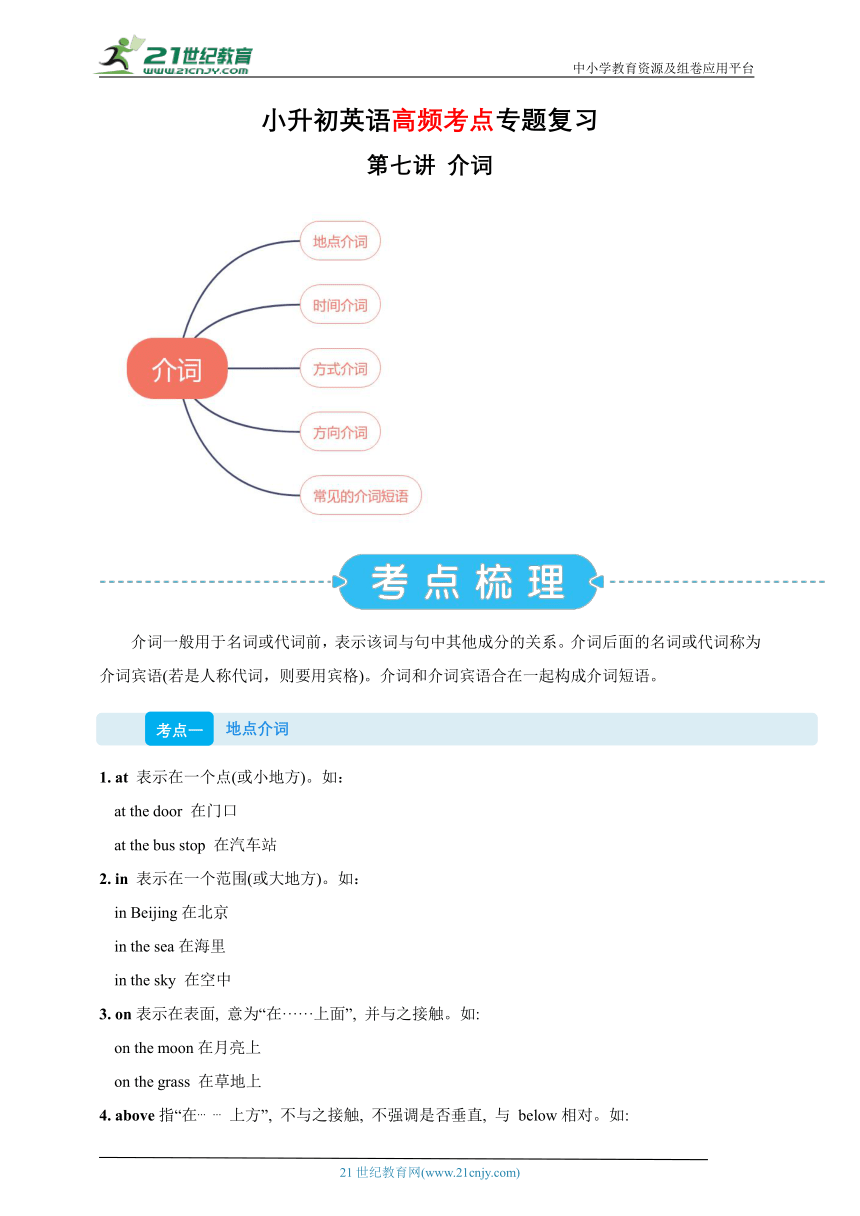 | |
| 格式 | docx | ||
| 文件大小 | 564.9KB | ||
| 资源类型 | 试卷 | ||
| 版本资源 | 通用版 | ||
| 科目 | 英语 | ||
| 更新时间 | 2024-04-12 10:02:09 | ||
图片预览

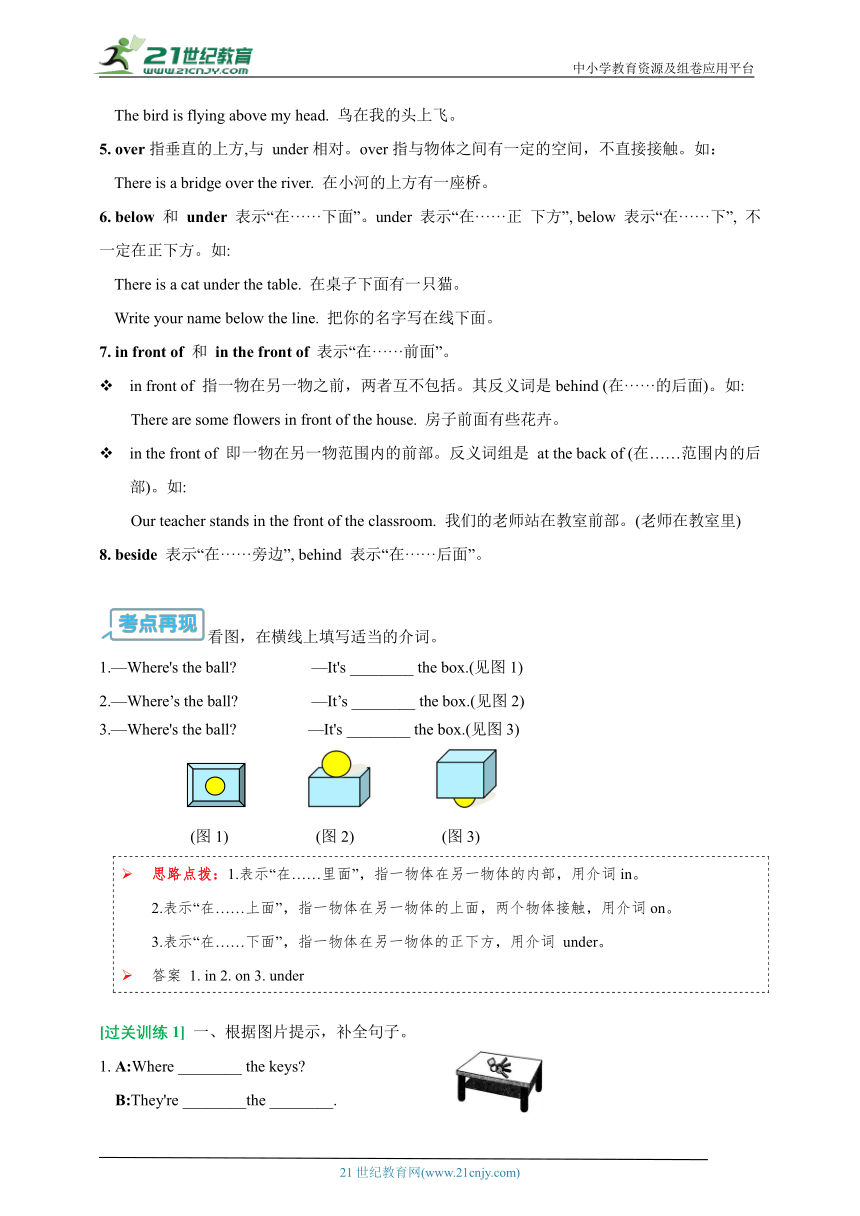
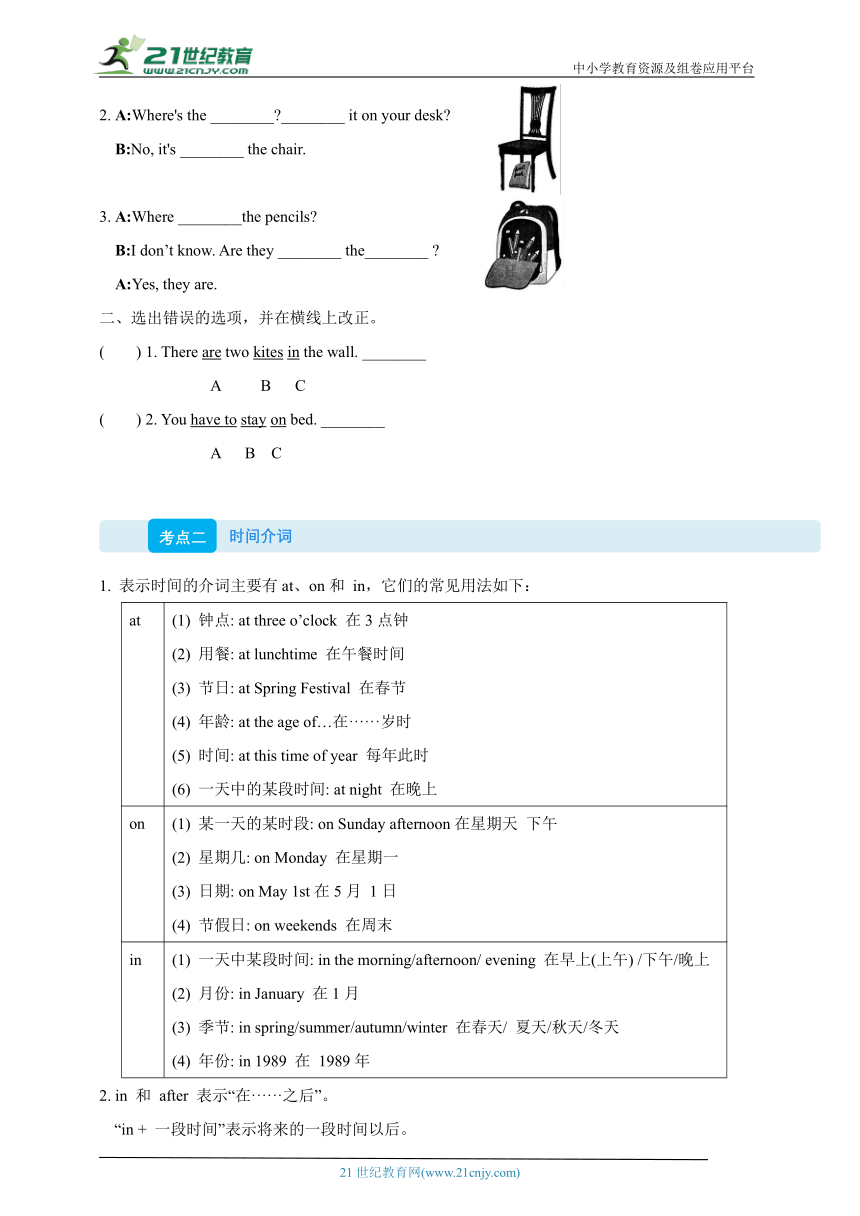
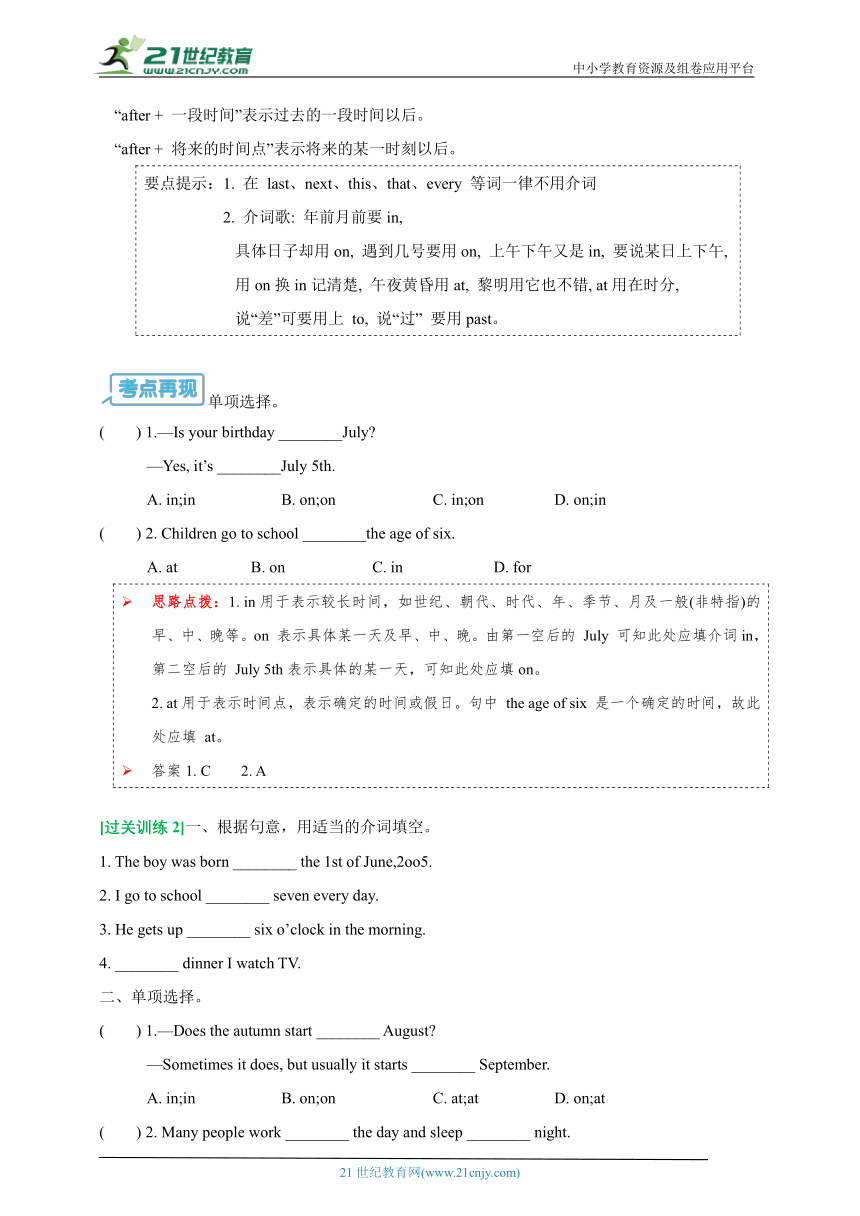
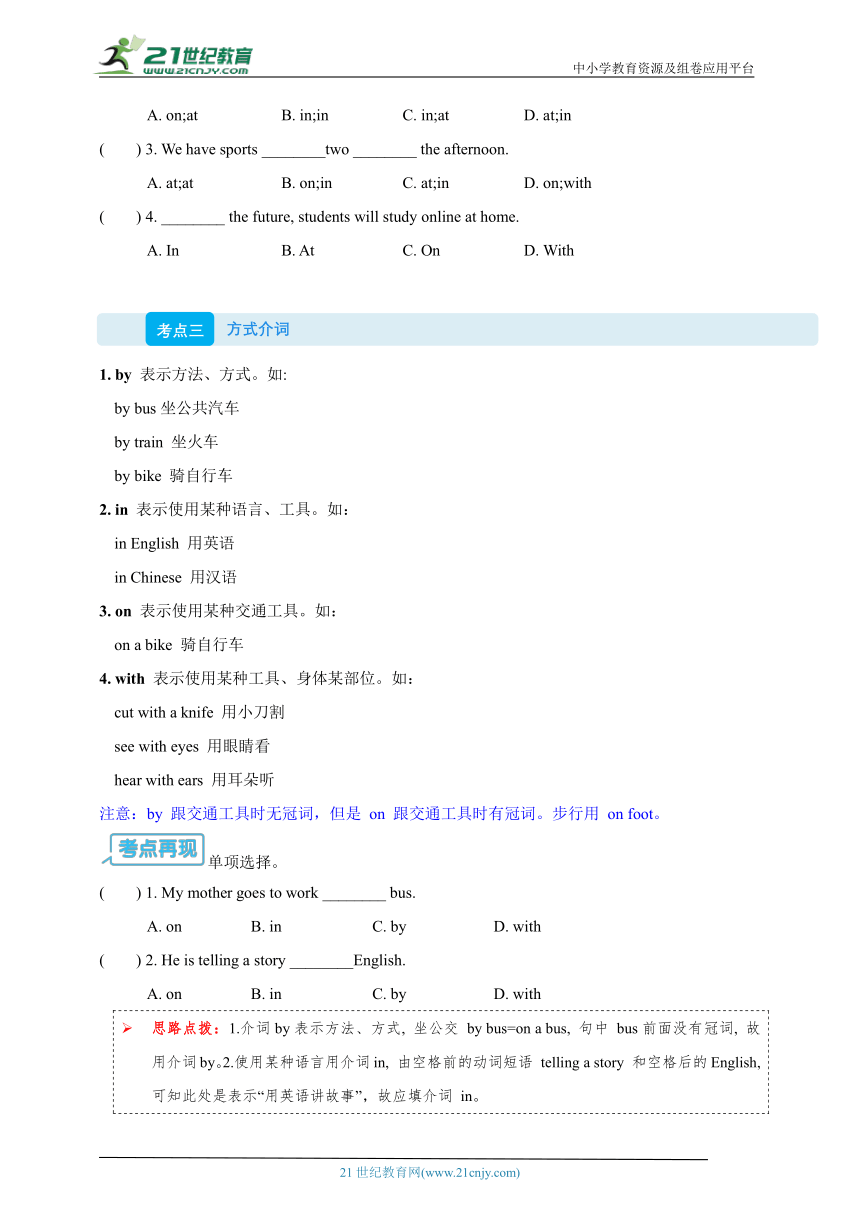
文档简介
中小学教育资源及组卷应用平台
小升初英语高频考点专题复习
第七讲 介词
介词一般用于名词或代词前,表示该词与句中其他成分的关系。介词后面的名词或代词称为介词宾语(若是人称代词,则要用宾格)。介词和介词宾语合在一起构成介词短语。
1. at 表示在一个点(或小地方)。如:
at the door 在门口
at the bus stop 在汽车站
2. in 表示在一个范围(或大地方)。如:
in Beijing在北京
in the sea在海里
in the sky 在空中
3. on表示在表面, 意为“在······上面”, 并与之接触。如:
on the moon在月亮上
on the grass 在草地上
4. above指“在 上方”, 不与之接触, 不强调是否垂直, 与 below相对。如:
The bird is flying above my head. 鸟在我的头上飞。
5. over指垂直的上方,与 under相对。over指与物体之间有一定的空间,不直接接触。如:
There is a bridge over the river. 在小河的上方有一座桥。
6. below 和 under 表示“在······下面”。under 表示“在······正 下方”, below 表示“在······下”, 不一定在正下方。如:
There is a cat under the table. 在桌子下面有一只猫。
Write your name below the line. 把你的名字写在线下面。
7. in front of 和 in the front of 表示“在······前面”。
in front of 指一物在另一物之前,两者互不包括。其反义词是behind (在······的后面)。如:
There are some flowers in front of the house. 房子前面有些花卉。
in the front of 即一物在另一物范围内的前部。反义词组是 at the back of (在……范围内的后部)。如:
Our teacher stands in the front of the classroom. 我们的老师站在教室前部。(老师在教室里)
8. beside 表示“在······旁边”, behind 表示“在······后面”。
看图,在横线上填写适当的介词。
1.—Where's the ball —It's ________ the box.(见图1)
2.—Where’s the ball —It’s ________ the box.(见图2)
3.—Where's the ball —It's ________ the box.(见图3)
(图1) (图2) (图3)
思路点拨:1.表示“在……里面”,指一物体在另一物体的内部,用介词in。 2.表示“在……上面”,指一物体在另一物体的上面,两个物体接触,用介词on。 3.表示“在……下面”,指一物体在另一物体的正下方,用介词 under。 答案 1. in 2. on 3. under
[过关训练1] 一、根据图片提示,补全句子。
1. A:Where ________ the keys
B:They're ________the ________.
2. A:Where's the ________ ________ it on your desk
B:No, it's ________ the chair.
3. A:Where ________the pencils
B:I don’t know. Are they ________ the________
A:Yes, they are.
二、选出错误的选项,并在横线上改正。
( ) 1. There are two kites in the wall. ________
A B C
( ) 2. You have to stay on bed. ________
A B C
1. 表示时间的介词主要有at、on和 in,它们的常见用法如下:
at (1) 钟点: at three o’clock 在3点钟 (2) 用餐: at lunchtime 在午餐时间 (3) 节日: at Spring Festival 在春节 (4) 年龄: at the age of…在······岁时 (5) 时间: at this time of year 每年此时 (6) 一天中的某段时间: at night 在晚上
on (1) 某一天的某时段: on Sunday afternoon在星期天 下午 (2) 星期几: on Monday 在星期一 (3) 日期: on May 1st在5月 1日 (4) 节假日: on weekends 在周末
in (1) 一天中某段时间: in the morning/afternoon/ evening 在早上(上午) /下午/晚上 (2) 月份: in January 在1月 (3) 季节: in spring/summer/autumn/winter 在春天/ 夏天/秋天/冬天 (4) 年份: in 1989 在 1989年
2. in 和 after 表示“在······之后”。
“in + 一段时间”表示将来的一段时间以后。
“after + 一段时间”表示过去的一段时间以后。
“after + 将来的时间点”表示将来的某一时刻以后。
要点提示:1. 在 last、next、this、that、every 等词一律不用介词 2. 介词歌: 年前月前要in, 具体日子却用on, 遇到几号要用on, 上午下午又是in, 要说某日上下午, 用on换in记清楚, 午夜黄昏用at, 黎明用它也不错, at用在时分, 说“差”可要用上 to, 说“过” 要用past。
单项选择。
( ) 1.—Is your birthday ________July
—Yes, it’s ________July 5th.
A. in;in B. on;on C. in;on D. on;in
( ) 2. Children go to school ________the age of six.
A. at B. on C. in D. for
思路点拨:1. in用于表示较长时间,如世纪、朝代、时代、年、季节、月及一般(非特指)的早、中、晚等。on 表示具体某一天及早、中、晚。由第一空后的 July 可知此处应填介词in,第二空后的 July 5th表示具体的某一天,可知此处应填on。 2. at用于表示时间点,表示确定的时间或假日。句中 the age of six 是一个确定的时间,故此处应填 at。 答案1. C 2. A
[过关训练2]一、根据句意,用适当的介词填空。
1. The boy was born ________ the 1st of June,2oo5.
2. I go to school ________ seven every day.
3. He gets up ________ six o’clock in the morning.
4. ________ dinner I watch TV.
二、单项选择。
( ) 1.—Does the autumn start ________ August
—Sometimes it does, but usually it starts ________ September.
A. in;in B. on;on C. at;at D. on;at
( ) 2. Many people work ________ the day and sleep ________ night.
A. on;at B. in;in C. in;at D. at;in
( ) 3. We have sports ________two ________ the afternoon.
A. at;at B. on;in C. at;in D. on;with
( ) 4. ________ the future, students will study online at home.
A. In B. At C. On D. With
1. by 表示方法、方式。如:
by bus坐公共汽车
by train 坐火车
by bike 骑自行车
2. in 表示使用某种语言、工具。如:
in English 用英语
in Chinese 用汉语
3. on 表示使用某种交通工具。如:
on a bike 骑自行车
4. with 表示使用某种工具、身体某部位。如:
cut with a knife 用小刀割
see with eyes 用眼睛看
hear with ears 用耳朵听
注意:by 跟交通工具时无冠词,但是 on 跟交通工具时有冠词。步行用 on foot。
单项选择。
( ) 1. My mother goes to work ________ bus.
A. on B. in C. by D. with
( ) 2. He is telling a story ________English.
A. on B. in C. by D. with
思路点拨:1.介词by表示方法、方式, 坐公交 by bus=on a bus, 句中 bus前面没有冠词, 故用介词by。2.使用某种语言用介词in, 由空格前的动词短语 telling a story 和空格后的English, 可知此处是表示“用英语讲故事”,故应填介词 in。 答案 1. C 2. B
[过关训练3]一、单项选择。
( ) 1.(扬州) How did Colin go to the Secret Garden at first
A. By a car. B. On his foot. C. By wheelchair. D. By the bike.
( ) 2. I can see ________ my eyes.
A. on B. by C. with D. in
( ) 3. What's this ________English
A. in B. at C. on D. under
( ) 4. Sometimes I go to school ________bike.
A. by B. in C. on D. with
二、选出错误的选项,并在横线上改正。
( ) 1. She usually goes to school by foot. ________
A B C
( ) 2. Can you say it on English ________
A B C
1. from表示运动的始发地。如:
She flies from China to Japan five times a month. 她每个月要从中国飞往日本五次。
2. to 表示运动的目的地。如:
I went to her. 我去了她那里。
3. for表示“向 , 往 ”。如:
He will leave for Shanghai next week. 他下周去上海。
4. up表示方向朝上或向北方。down 表示方向朝下或向南方。 along 表示“沿着 ”。如:
I ran up the hill. 我跑上山。
Go along this street. 沿着这条街走。
注意:介词for后面可跟目的地。
单项选择。
( ) 1. Mr Brown comes ________ America.
A. at B. from C. in D. on
( ) 2. They will move ________ the new school next Monday.
A. on B. in C. to D. up
思路点拨:1. come from=be from, 意为“来自于”, 介词 from 表示来自始发地。 2.由空格后的the new school, 可知空格处的介词表示目的地, 故应填to。 答案 1. B 2. C
[过关训练4]一、根据句意,用适当的介词填空。
1. Jim comes ________Japan. He is Japanese.
2. There is a letter ________ you.
3. Go ________the street, and you’ll find the post office.
二、单项选择。
( ) 1. Here is a present ________you, Nancy. It's ________ your grandma.
A. from;for B. for;from C. for;for D. from;from
( ) 2. It's time ________ school. Let's go ________ school.
A. to;for B. to;to C. for;to D. for;for
( ) 3. Count ________ one ________ten.
A. from;by B. from;to C. to;to D. at;to
( ) 4. Hong Kong is ________ the south of China, and Macao is ________ the west of Hong Kong.
A. in;to B. to;to C. to;in D. in;in
1. 常用介词和名词的连用。以下是由at、on 和 in构成的一些 常见的介词短语。
(1) at
at work在工作 at dinner在吃晚饭 at home在家 at school在学校
(2) on
on duty 值日 on holiday 度假 on time 准时 on foot步行
on the left/right 在左边/右边 on TV 在电视上播放 on the phone 在通话中 on the way在路上
(3) in
in bed躺在床上 in class 在课堂上 in English 用英语
in the end 最后 in time 及时地 in a minute 立刻;马上
2. 动词和介词的连用。
go to bed上床睡觉 go to work 上班 go to school 上学
listen to 听 write to 给······写信 hear of 听说
hear from收到······的来信 look for 寻找 look at 看
look after 照顾 wait for等待 get to 到达
get on 上车 get off 下车 learn from 向……学习
put on 穿上 take off脱下 agree with 同意
think about 认为; 考虑 think of想到; 认为 laugh at 嘲笑
talk about 谈论 worry about 为……担忧 turn on 打开
come from 来自 welcome to 欢迎来到……
3. 形容词和介词的连用。
be afraid of 对……感到害怕 be good for 对……有好处
be interested in 对……感兴趣 be bad for 对······有害处
be strict with 对……很严格 be late for 迟到
be busy with 忙于 be ready for 为……做好准备
be good at擅长 be different from 与……不同
be afraid of 对……感到害怕 be far from 离……远
be interested in 对……感兴趣 be near to 离……近
4. 其他。
by +交通工具: by bus/train/plane/air/ship/bike of course 当然
by oneself 独自 at most 至多
by the way 顺便问一下 at least 至少
lots of/ a lot of许多; 大量 at once 立即; 马上
单项选择。
( ) 1. My sister is looking ________ her new shoes now.
A. up B. after C. for D. to
( ) 2. It's cold outside. Please ________ your warm clothes.
A. put in B. take off C. put on D. put up
思路点拨:1.单词look 与不同的介词搭配,构成的介词短语表达的意义不同。look up 表示“查找”, look after 表示“照顾”, look for表示“寻找”, 根据句意可知此处应填介词for。 2.结合第一句中的cold 和空格后的 warm clothes,可知空格处表达的意思是“穿上”, 故应填短语 put on。 答案 1. C 2. C
[过关训练5] 一、用适当的介词补全下列短语。
1. ________first 2. ________front of
3. because ________ 4.________time
5. ________ the way 6. be interested ________
7. be good ________ 8.________course
二、单项选择。
( ) 1.I often help my sister ________ her homework.
A. in B. with C. for D. to
( ) 2.Look ________the window. There is heavy rain.
A. out of B. out for C. out D. for
( ) 3. The supermarket is far ________ my home.
A. from B. to C. for D. on
( ) 4. The classroom is quite different ________ that one.
A. of B. from C. with D. like
( ) 5. What do you think ________ the play(戏剧)
A. about B. of C. for D. like
过关训练参考答案
[过关训练1]
一、1. are on table/desk 2. book Is under
3. are in schoolbag
二、1. C on 2. C in二、1. C 2. B 3. D 4. A
[过关训练2]
一、1. on 2. at 3. at 4. After
二、1. A 2. C 3. C 4. A
[过关训练3]
一、1. C 2. C 3. A 4. A
二、1. C on 2. B in
[过关训练4]
一、1. from 2. for 3. along
二、1. B 2. C 3. B 4. A
[过关训练5]
一、1. at 2. in 3. of 4. in/on 5. by 6. in7. at/for 8. of
二、1. B 2. A 3. A 4. B 5. B
21世纪教育网 www.21cnjy.com 精品试卷·第 2 页 (共 2 页)
21世纪教育网(www.21cnjy.com)
小升初英语高频考点专题复习
第七讲 介词
介词一般用于名词或代词前,表示该词与句中其他成分的关系。介词后面的名词或代词称为介词宾语(若是人称代词,则要用宾格)。介词和介词宾语合在一起构成介词短语。
1. at 表示在一个点(或小地方)。如:
at the door 在门口
at the bus stop 在汽车站
2. in 表示在一个范围(或大地方)。如:
in Beijing在北京
in the sea在海里
in the sky 在空中
3. on表示在表面, 意为“在······上面”, 并与之接触。如:
on the moon在月亮上
on the grass 在草地上
4. above指“在 上方”, 不与之接触, 不强调是否垂直, 与 below相对。如:
The bird is flying above my head. 鸟在我的头上飞。
5. over指垂直的上方,与 under相对。over指与物体之间有一定的空间,不直接接触。如:
There is a bridge over the river. 在小河的上方有一座桥。
6. below 和 under 表示“在······下面”。under 表示“在······正 下方”, below 表示“在······下”, 不一定在正下方。如:
There is a cat under the table. 在桌子下面有一只猫。
Write your name below the line. 把你的名字写在线下面。
7. in front of 和 in the front of 表示“在······前面”。
in front of 指一物在另一物之前,两者互不包括。其反义词是behind (在······的后面)。如:
There are some flowers in front of the house. 房子前面有些花卉。
in the front of 即一物在另一物范围内的前部。反义词组是 at the back of (在……范围内的后部)。如:
Our teacher stands in the front of the classroom. 我们的老师站在教室前部。(老师在教室里)
8. beside 表示“在······旁边”, behind 表示“在······后面”。
看图,在横线上填写适当的介词。
1.—Where's the ball —It's ________ the box.(见图1)
2.—Where’s the ball —It’s ________ the box.(见图2)
3.—Where's the ball —It's ________ the box.(见图3)
(图1) (图2) (图3)
思路点拨:1.表示“在……里面”,指一物体在另一物体的内部,用介词in。 2.表示“在……上面”,指一物体在另一物体的上面,两个物体接触,用介词on。 3.表示“在……下面”,指一物体在另一物体的正下方,用介词 under。 答案 1. in 2. on 3. under
[过关训练1] 一、根据图片提示,补全句子。
1. A:Where ________ the keys
B:They're ________the ________.
2. A:Where's the ________ ________ it on your desk
B:No, it's ________ the chair.
3. A:Where ________the pencils
B:I don’t know. Are they ________ the________
A:Yes, they are.
二、选出错误的选项,并在横线上改正。
( ) 1. There are two kites in the wall. ________
A B C
( ) 2. You have to stay on bed. ________
A B C
1. 表示时间的介词主要有at、on和 in,它们的常见用法如下:
at (1) 钟点: at three o’clock 在3点钟 (2) 用餐: at lunchtime 在午餐时间 (3) 节日: at Spring Festival 在春节 (4) 年龄: at the age of…在······岁时 (5) 时间: at this time of year 每年此时 (6) 一天中的某段时间: at night 在晚上
on (1) 某一天的某时段: on Sunday afternoon在星期天 下午 (2) 星期几: on Monday 在星期一 (3) 日期: on May 1st在5月 1日 (4) 节假日: on weekends 在周末
in (1) 一天中某段时间: in the morning/afternoon/ evening 在早上(上午) /下午/晚上 (2) 月份: in January 在1月 (3) 季节: in spring/summer/autumn/winter 在春天/ 夏天/秋天/冬天 (4) 年份: in 1989 在 1989年
2. in 和 after 表示“在······之后”。
“in + 一段时间”表示将来的一段时间以后。
“after + 一段时间”表示过去的一段时间以后。
“after + 将来的时间点”表示将来的某一时刻以后。
要点提示:1. 在 last、next、this、that、every 等词一律不用介词 2. 介词歌: 年前月前要in, 具体日子却用on, 遇到几号要用on, 上午下午又是in, 要说某日上下午, 用on换in记清楚, 午夜黄昏用at, 黎明用它也不错, at用在时分, 说“差”可要用上 to, 说“过” 要用past。
单项选择。
( ) 1.—Is your birthday ________July
—Yes, it’s ________July 5th.
A. in;in B. on;on C. in;on D. on;in
( ) 2. Children go to school ________the age of six.
A. at B. on C. in D. for
思路点拨:1. in用于表示较长时间,如世纪、朝代、时代、年、季节、月及一般(非特指)的早、中、晚等。on 表示具体某一天及早、中、晚。由第一空后的 July 可知此处应填介词in,第二空后的 July 5th表示具体的某一天,可知此处应填on。 2. at用于表示时间点,表示确定的时间或假日。句中 the age of six 是一个确定的时间,故此处应填 at。 答案1. C 2. A
[过关训练2]一、根据句意,用适当的介词填空。
1. The boy was born ________ the 1st of June,2oo5.
2. I go to school ________ seven every day.
3. He gets up ________ six o’clock in the morning.
4. ________ dinner I watch TV.
二、单项选择。
( ) 1.—Does the autumn start ________ August
—Sometimes it does, but usually it starts ________ September.
A. in;in B. on;on C. at;at D. on;at
( ) 2. Many people work ________ the day and sleep ________ night.
A. on;at B. in;in C. in;at D. at;in
( ) 3. We have sports ________two ________ the afternoon.
A. at;at B. on;in C. at;in D. on;with
( ) 4. ________ the future, students will study online at home.
A. In B. At C. On D. With
1. by 表示方法、方式。如:
by bus坐公共汽车
by train 坐火车
by bike 骑自行车
2. in 表示使用某种语言、工具。如:
in English 用英语
in Chinese 用汉语
3. on 表示使用某种交通工具。如:
on a bike 骑自行车
4. with 表示使用某种工具、身体某部位。如:
cut with a knife 用小刀割
see with eyes 用眼睛看
hear with ears 用耳朵听
注意:by 跟交通工具时无冠词,但是 on 跟交通工具时有冠词。步行用 on foot。
单项选择。
( ) 1. My mother goes to work ________ bus.
A. on B. in C. by D. with
( ) 2. He is telling a story ________English.
A. on B. in C. by D. with
思路点拨:1.介词by表示方法、方式, 坐公交 by bus=on a bus, 句中 bus前面没有冠词, 故用介词by。2.使用某种语言用介词in, 由空格前的动词短语 telling a story 和空格后的English, 可知此处是表示“用英语讲故事”,故应填介词 in。 答案 1. C 2. B
[过关训练3]一、单项选择。
( ) 1.(扬州) How did Colin go to the Secret Garden at first
A. By a car. B. On his foot. C. By wheelchair. D. By the bike.
( ) 2. I can see ________ my eyes.
A. on B. by C. with D. in
( ) 3. What's this ________English
A. in B. at C. on D. under
( ) 4. Sometimes I go to school ________bike.
A. by B. in C. on D. with
二、选出错误的选项,并在横线上改正。
( ) 1. She usually goes to school by foot. ________
A B C
( ) 2. Can you say it on English ________
A B C
1. from表示运动的始发地。如:
She flies from China to Japan five times a month. 她每个月要从中国飞往日本五次。
2. to 表示运动的目的地。如:
I went to her. 我去了她那里。
3. for表示“向 , 往 ”。如:
He will leave for Shanghai next week. 他下周去上海。
4. up表示方向朝上或向北方。down 表示方向朝下或向南方。 along 表示“沿着 ”。如:
I ran up the hill. 我跑上山。
Go along this street. 沿着这条街走。
注意:介词for后面可跟目的地。
单项选择。
( ) 1. Mr Brown comes ________ America.
A. at B. from C. in D. on
( ) 2. They will move ________ the new school next Monday.
A. on B. in C. to D. up
思路点拨:1. come from=be from, 意为“来自于”, 介词 from 表示来自始发地。 2.由空格后的the new school, 可知空格处的介词表示目的地, 故应填to。 答案 1. B 2. C
[过关训练4]一、根据句意,用适当的介词填空。
1. Jim comes ________Japan. He is Japanese.
2. There is a letter ________ you.
3. Go ________the street, and you’ll find the post office.
二、单项选择。
( ) 1. Here is a present ________you, Nancy. It's ________ your grandma.
A. from;for B. for;from C. for;for D. from;from
( ) 2. It's time ________ school. Let's go ________ school.
A. to;for B. to;to C. for;to D. for;for
( ) 3. Count ________ one ________ten.
A. from;by B. from;to C. to;to D. at;to
( ) 4. Hong Kong is ________ the south of China, and Macao is ________ the west of Hong Kong.
A. in;to B. to;to C. to;in D. in;in
1. 常用介词和名词的连用。以下是由at、on 和 in构成的一些 常见的介词短语。
(1) at
at work在工作 at dinner在吃晚饭 at home在家 at school在学校
(2) on
on duty 值日 on holiday 度假 on time 准时 on foot步行
on the left/right 在左边/右边 on TV 在电视上播放 on the phone 在通话中 on the way在路上
(3) in
in bed躺在床上 in class 在课堂上 in English 用英语
in the end 最后 in time 及时地 in a minute 立刻;马上
2. 动词和介词的连用。
go to bed上床睡觉 go to work 上班 go to school 上学
listen to 听 write to 给······写信 hear of 听说
hear from收到······的来信 look for 寻找 look at 看
look after 照顾 wait for等待 get to 到达
get on 上车 get off 下车 learn from 向……学习
put on 穿上 take off脱下 agree with 同意
think about 认为; 考虑 think of想到; 认为 laugh at 嘲笑
talk about 谈论 worry about 为……担忧 turn on 打开
come from 来自 welcome to 欢迎来到……
3. 形容词和介词的连用。
be afraid of 对……感到害怕 be good for 对……有好处
be interested in 对……感兴趣 be bad for 对······有害处
be strict with 对……很严格 be late for 迟到
be busy with 忙于 be ready for 为……做好准备
be good at擅长 be different from 与……不同
be afraid of 对……感到害怕 be far from 离……远
be interested in 对……感兴趣 be near to 离……近
4. 其他。
by +交通工具: by bus/train/plane/air/ship/bike of course 当然
by oneself 独自 at most 至多
by the way 顺便问一下 at least 至少
lots of/ a lot of许多; 大量 at once 立即; 马上
单项选择。
( ) 1. My sister is looking ________ her new shoes now.
A. up B. after C. for D. to
( ) 2. It's cold outside. Please ________ your warm clothes.
A. put in B. take off C. put on D. put up
思路点拨:1.单词look 与不同的介词搭配,构成的介词短语表达的意义不同。look up 表示“查找”, look after 表示“照顾”, look for表示“寻找”, 根据句意可知此处应填介词for。 2.结合第一句中的cold 和空格后的 warm clothes,可知空格处表达的意思是“穿上”, 故应填短语 put on。 答案 1. C 2. C
[过关训练5] 一、用适当的介词补全下列短语。
1. ________first 2. ________front of
3. because ________ 4.________time
5. ________ the way 6. be interested ________
7. be good ________ 8.________course
二、单项选择。
( ) 1.I often help my sister ________ her homework.
A. in B. with C. for D. to
( ) 2.Look ________the window. There is heavy rain.
A. out of B. out for C. out D. for
( ) 3. The supermarket is far ________ my home.
A. from B. to C. for D. on
( ) 4. The classroom is quite different ________ that one.
A. of B. from C. with D. like
( ) 5. What do you think ________ the play(戏剧)
A. about B. of C. for D. like
过关训练参考答案
[过关训练1]
一、1. are on table/desk 2. book Is under
3. are in schoolbag
二、1. C on 2. C in二、1. C 2. B 3. D 4. A
[过关训练2]
一、1. on 2. at 3. at 4. After
二、1. A 2. C 3. C 4. A
[过关训练3]
一、1. C 2. C 3. A 4. A
二、1. C on 2. B in
[过关训练4]
一、1. from 2. for 3. along
二、1. B 2. C 3. B 4. A
[过关训练5]
一、1. at 2. in 3. of 4. in/on 5. by 6. in7. at/for 8. of
二、1. B 2. A 3. A 4. B 5. B
21世纪教育网 www.21cnjy.com 精品试卷·第 2 页 (共 2 页)
21世纪教育网(www.21cnjy.com)
